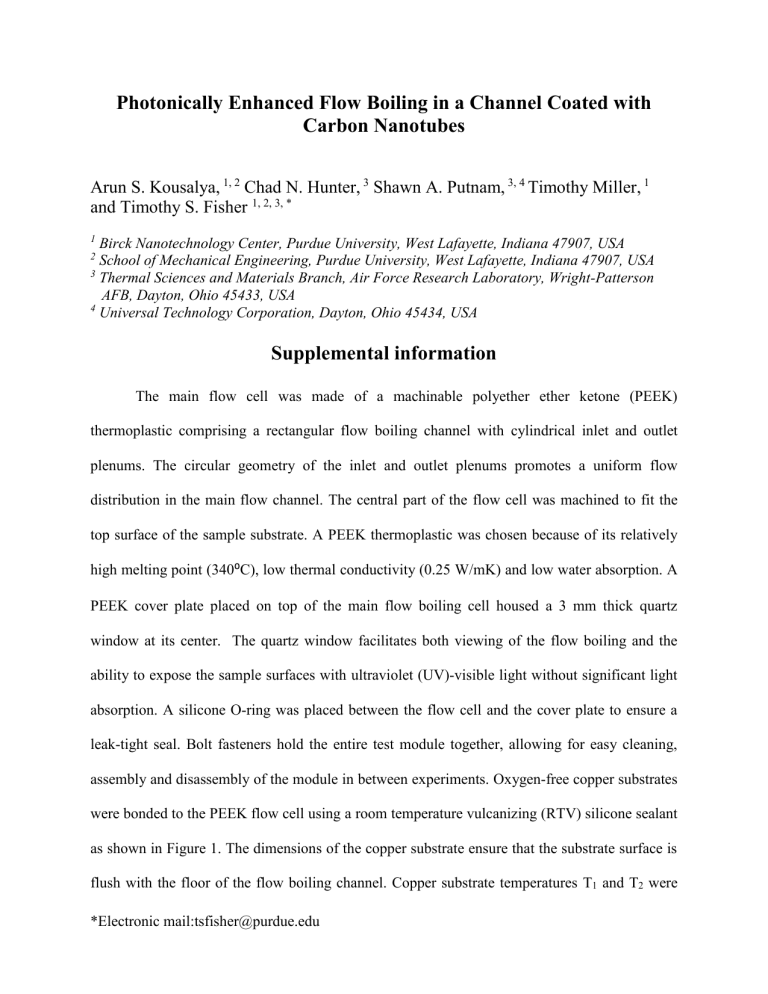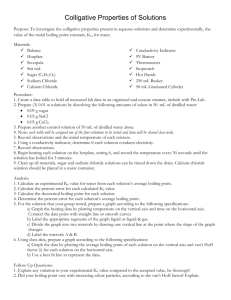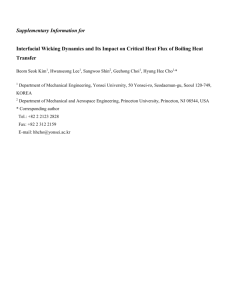Photonically enhanced flow

Photonically Enhanced Flow Boiling in a Channel Coated with
Carbon Nanotubes
Arun S. Kousalya,
1, 2
Chad N. Hunter,
3
Shawn A. Putnam,
3, 4
Timothy Miller,
1
and Timothy S. Fisher
1, 2, 3, *
1 Birck Nanotechnology Center, Purdue University, West Lafayette, Indiana 47907, USA
2
School of Mechanical Engineering, Purdue University, West Lafayette, Indiana 47907, USA
3
Thermal Sciences and Materials Branch, Air Force Research Laboratory, Wright-Patterson
AFB, Dayton, Ohio 45433, USA
4
Universal Technology Corporation, Dayton, Ohio 45434, USA
Supplemental information
The main flow cell was made of a machinable polyether ether ketone (PEEK) thermoplastic comprising a rectangular flow boiling channel with cylindrical inlet and outlet plenums. The circular geometry of the inlet and outlet plenums promotes a uniform flow distribution in the main flow channel. The central part of the flow cell was machined to fit the top surface of the sample substrate. A PEEK thermoplastic was chosen because of its relatively high melting point (340 ⁰ C), low thermal conductivity (0.25 W/mK) and low water absorption. A
PEEK cover plate placed on top of the main flow boiling cell housed a 3 mm thick quartz window at its center. The quartz window facilitates both viewing of the flow boiling and the ability to expose the sample surfaces with ultraviolet (UV)-visible light without significant light absorption. A silicone O-ring was placed between the flow cell and the cover plate to ensure a leak-tight seal. Bolt fasteners hold the entire test module together, allowing for easy cleaning, assembly and disassembly of the module in between experiments. Oxygen-free copper substrates were bonded to the PEEK flow cell using a room temperature vulcanizing (RTV) silicone sealant as shown in Figure 1. The dimensions of the copper substrate ensure that the substrate surface is flush with the floor of the flow boiling channel. Copper substrate temperatures T
1
and T
2
were
*Electronic mail:tsfisher@purdue.edu
monitored by two T-type thermocouples placed symmetrically. Heat was supplied by a Watlow ultramic resistance heater (240 V, 967 W) connected to an external power supply (Sorensen DHP
300). Thermal contact conductance between the copper test substrate and the ceramic heater was enhanced by inserting a 25 µm copper foil. A high-temperature ceramic tape and a ceramic block were used to insulate the resistance heater from the bottom aluminum support plate. The inlet fluid pressure P in
was measured by an absolute pressure transducer from Omega (PX409-
050A5V).
Ultra-pure water supplied from a central water treatment system was both degasified and deionized with 10 parts per billion dissolved oxygen, 15 parts per trillion boron and 250 parts per trillion total oxidizable carbon.
1
Water, initially at room temperature was heated by the inline heater from Omega (AHPF-121) in order to obtain an inlet temperature of 59.5±0.5
⁰ C at the test module. Prior to the heater, water passed through a 15 μ m filter and a flowmeter from Mcmillan
(106-5-D-T4) where the volumetric flow rate V f
was measured. The inlet and outlet water temperatures T in
and T out
were measured by T-type thermocouples installed in the inlet and outlet plenums, respectively. The inlet pressure P in
was consistently maintained close to atmospheric pressure during all the experiments. The fluid and copper substrate temperatures and the inlet pressure were measured by a Keithley 2601 data acquisition (DAQ) system interfaced to a PC.
Test surfaces were illuminated with a low intensity UV-visible (UV-VIS) light-emitting diode (LED) area light (Edmund Optics, NT59-369), having a central wavelength and full width at half maximum of 370 nm and 25 nm, respectively. Multiple plano-convex lenses were used to focus the beam onto an 8 mm square area with an effective focal length of 41.25 mm (as measured from the last plano-convex lens). Total power output from the LED area light was measured to be 53 mW using a Newport photo detector (818 series) and a power meter, resulting
in an optical energy flux of 83 mW/cm
2
. A low-intensity light source was used to minimize heating of the sample surface by the UV-VIS light. This light source ensures that any enhancements in flow boiling performance due to photo-excitation are not the result of broad area surface heating by the light source. For example, assuming 100% light absorption, the energy fluxes from the light source are at least two orders of magnitude less than the heat fluxes measured during flow boiling. We also note that only 21% of the area of the sample substrate was exposed to the light source.
The flow boiling tests were performed with inlet temperature of 59.5±0.5
⁰ C and a volumetric flow rate of 222 ml/min. A relatively low volumetric flow rate was employed to ensure laminar flow, yielding a Reynolds number Re ≅ 675 and a mass velocity G ≅ 38 kg/m
2 s
(based on the ratio of mass flow rate and the cross sectional area of the channel). At the start of the experiments, the system was flushed with degasified water for 60 minutes. A control valve facilitated precise control of the volumetric flow rate. The water inlet temperature was controlled by the inline heater using a 0-140 Variac. Once steady state was attained for the fluid inlet conditions, the power to the resistive heater was incremented while monitoring the copper substrate and fluid temperatures. At each increment, the system was allowed to come to steady state for a minimum period of 10 minutes before thermal data were recorded. The steady state temperature data recorded is the average of 100 readings. The same procedure was repeated until a maximum set-point heater power of 175 W was reached.
Surface temperature prediction and heat flux estimation form a significant component of a flow boiling test setup. In case of single-phase flow, the surface heat flux q " sp was estimated based on the expression q " sp
= ρV f
C p
(T out
− T in
⁄
2
, assuming insignificant energy losses to the PEEK flow cell. In the above expression, ρ denotes the density of water as a function of
mean fluid temperature T m
, V f
the volumetric rate, C p
represents the specific heat capacity at constant pressure and A
2
represents the boiling surface area. Temperature variations of density ρ and specific heat capacity C p
of water were incorporated in the calculations using the mean fluid temperature T m
. Heat loss through the heater network Q loss-sp
as a function of surface temperature of copper substrate in case of a single phase flow was determined as the difference between input power Q input
= VI and the sensible heat gain by the fluid Q sp
. V denotes the voltage applied and the I denotes the current through the resistance heater. Substantial increments in surface temperature were observed with the increase in heat flux in case of a single phase flow. A linear fit was obtained for the variation of heat loss with respect to surface temperature indicating that conduction was the dominant heat transfer mechanism. After the onset of boiling, although the increments in surface temperature decreased considerably with the decrease in the resistance to heat transfer through the surface, conduction still remained the dominant mechanism of heat transfer. Hence the linear fit obtained before was used to estimate the heat loss during two-phase flow Q loss-tp
.
2
The total heat flux reaching the boiling surface in case of a two-phase flow was estimated as q " tp
= (Q input
− Q loss−tp
)/A
2
.
The surface temperature of the copper surface T s,i
exposed to the water was determined utilizing the estimated heat flux and using Fourier’s law assuming one dimensional heat conduction, where i denotes either 1 or 2. Any losses to the sealant used for bonding were neglected because of its low thermal conductivity. The expression T s,i
= T i
− q " ⁄ k
Cu
∗ [t
1
(A
1
⁄ A
2
) + t
2
] was utilized to predict the surface temperature, where T i represents the recorded temperature of copper block and k
Cu
, the thermal conductivity of the oxygen-free copper block. q "
is used as a common term to symbolize the estimated heat flux both in the single- and two-phase flows. A
1
represent the area of the protrusion used for sealing and A
2
represents the area of top platform of the copper substrate. Both the areas considered here are normal to the direction of the assumed one-dimensional heat flow, t
1
measures the total thickness of the protrusion and t
2
represents the sum total of the thickness of the upper platform and thickness of the copper substrate from the center of the thermocouple hole to the intersection of the protrusion. The average surface temperature T s
was computed as the mean of the two predicted surface temperatures. The methodology described hereby was consistently adopted while reporting the heat flux and surface temperatures in this study.
The meter used to measure the electrical power input had an accuracy of 3%. The T-type thermocouples had an uncertainty of 0.4
⁰ C and the Mcmillan flow meter had an accuracy of 3%.
A 5% error in thermal conductivity was assumed along with a dimensional error Δ x of 0.1 mm possible due to machining. A 10% error was assumed in calculating the single phase sensible heat gain. Quantification of uncertainties in prediction of surface temperature and estimation of heat flux was performed using the above specifications. Uncertainties in surface temperature prediction are reported in the figure 4 (a) and 4 (b). Heat flux uncertainties were within 11.5% of the reported data.
References
1
2
T.J.Miller, presented at the Ultrapure Water Micro, Phoenix, AZ (2010).
T. Chen and S. V. Garimella, Journal of Electronic Packaging 128 (4), 398-404 (2006).






